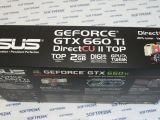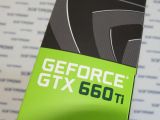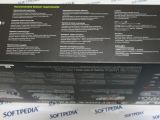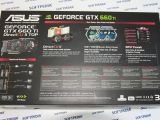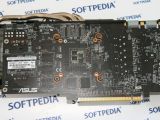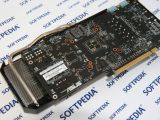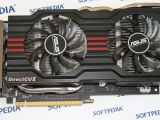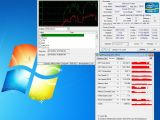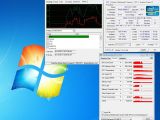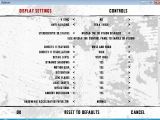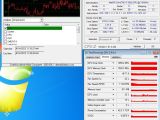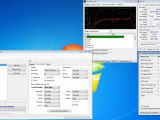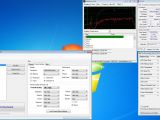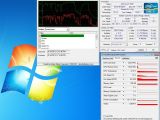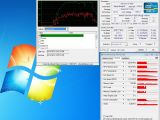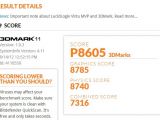In the whole war going on at the $300 price point on the video card market, we were lucky enough to get our hands on the most powerful Nvidia GeForce GTX 660 Ti video card on the market. From the list we’ve uncovered here, ASUS’ GeForce GTX 660Ti DirectCU II TOP video card is the faster 3D adapter built using Nvidia’s GTX 660 GPU.
We’ve already detailed the card here, but we’re going to make a quick recap now.
The GPU at the heart of this video card is Nvidia’s GK104 Kepler chip in its A2 revision as identified by the latest version of GPU-Z.
Officially, the GK104-300-KD-A2 GPU should be just the same with the ones used on the GTX 670 and GTX 680 video cards.
We know that the yields at TSMC are improving, but we believe that these are good enough right now as Nvidia wouldn’t rush out with the GTX 660 Ti otherwise.
Getting back to the reference specifications of the GTX 660 Ti architecture, we now know that the cards come with 1344 CUDA core active and work through a narrower 192-bit memory BUS with the 2048 MB of GDDR5 memory.
There are 112 TMUs and 24 ROPs inside this version of Kepler.
The reference frequencies recommended by Nvidia for the GTX 660 Ti video cards are 980 MHz for the GPU, 1032 MHz with the Boost activated and the usual 6008 MHz effective GDDR5 frequency.
The 2048 MB of GDDR5 memory on the 192-bit memory BUS should provide a bandwidth of 144 GB/sec and, while considerably less than what AMD is able to achieve on its 384-bit BUS architecture, it is still enough to keep the GK104 well fed.
The card comes with official PCI Express 3.0 support and has complete DirectX 11.1 support. The ASUS GeForce GTX 660Ti DirectCU II TOP video card comes with a 1059 MHz default GPU frequency in 3D mode and a 1137 MHz Boost frequency option when the application requires maximum performance.
These are impressive default frequencies for a card that comes likes this directly out of the factory.
The default GPU speed is 8% higher than the reference recommendation from Nvidia and the Boost frequency is a significant 10% higher.The thing is that this is currently the fastest factory overclocked Nvidia GeForce GTX 660 Ti video card on the market. There may be faster models in the future from other manufacturers, but that’s a slim chance.
In our internal testing we have observed that the ASUS GeForce GTX 660Ti DirectCU II TOP video card automatically overclocks the GPU much higher than the 1137 Mhz stated by the manufacturer and also reported by the GPU-Z video card utility.
This was quite a nice and unexpected surprise, but we can happily report to you that the ASUS GeForce GTX 660Ti DirectCU II TOP video card clocks the GPU somewhere beyond 1293 MHz when in a heavy 3D application and that’s very good news for the gamers that don’t like to meddle with overclocking.The card comes with a very efficient cooling system that, despite the high factory overclock and the even higher boost option, doesn’t let the GPU go too far beyond the 70 degrees Celsius mark that is rarely reached.
Our test rig was set up into an environment with an average ambient temperature of 25 degrees Celsius and, despite being mounted in a monster Cooler Master Storm Trooper case with many cooling fans inside, we only have a single case fan active.
There are not that many readers who could afford such a computer case and we think that the average user will only have a 120-millimeter rear exhaust case cooling fan active on its system.Even with such modest active cooling, the case is pretty well ventilated naturally and the GPU never went beyond 73 degrees Celsius.
The cooling fans are usually spinning at around 1000 RPM and we would rather have them bellow 700 RPM.
The maximum fan speed we’ve managed to record on the ASUS GeForce GTX 660Ti DirectCU II TOP video card was 1620 RPM, but that rarely occurred and even so, the fans were absolutely not, even the slightest bit, louder than the rest of the system.
Our Apple colleague was sitting right next to our test rig and he couldn’t tell if it was on or off. We mention this just because he has the quietest system in the office and he’s usually very pretentious about fan noise.Later on, while testing in Serious Sam 3 we’ve managed to reach 73 degrees Celsius for brief moments after some serious testing. The cooling fans reached a high 1900 RPM while still being less louder than the ambient noise.
We would need a reference GeForce GTX 660 Ti video card from Nvidia to verify ASUS’ claim that the DirectCU II cooling solution is 20% better than the reference one, but we don’t have such a card since, so far at least, it doesn't exist.Overall, we’re satisfied with the level of cooling performance the DirectCU II from ASUS provides, considering the fact that the GPU reaches some very high frequencies during gaming and that ambient temperature was not the “ideal” 22 degrees Celsius, but rather closer to 25 ~ 26 degrees.
On the connectivity side, the ASUS GeForce GTX 660Ti DirectCU II TOP video card comes with two DVI ports on the I/O bracket along with an HDMI and a DisplayPort connector.
On top there is the usual SLI connector and the top 6-pin power inputs.
Performance wise, we’re pretty satisfied with what the ASUS GeForce GTX 660Ti DirectCU II TOP video card is able to pull off on our test rig.
Here are the specifications of our test system:
CPU: Intel Core i7-3820 QuadCore CPU @ 3600 Mhz Mainboard: ASUS Rampage IV Extreme , Intel X79 Chipset Memory: Kingston Quad Channel HyperX DDR3 8GB Memory Set Storage: 120 GB Kingston HyperX SandForce 2281 SSD Thermalright HR-02 Macho CPU cooler with LGA 2011 retention kit Operating System: Microsoft Windows 7 Professional – 64 Bit Edition
3D Synthetic and Gaming Testing
3D Mark Vantage
We’ve fired up our testing session with FutureMark’s classic 3D Mark Vantage test suite that yielded a P34415 result.
This is a DirectX 10 test, but our card launched today is set to battle the AMD Radeon HD 7950 and such an AMD GPU gets anywhere between 25000 and 29000 in this test. Thus we can say that ASUS’ GeForce GTX 660Ti DirectCU II TOP video card has successfully won this round.
During this session, the GPU reached a high 1294 MHz and temperature briefly touched 68 degrees Celsius while the maximum fan speed reached a modest 1620 RPM.
Hard Reset
Heated up from the previous test session, we continued with the entertaining Hard Reset benchmark where we maxed out the quality settings and used Nvidia’s favorite FXAA option.
The game was tested in the popular 1680 by 1050 resolution that’s quite suitable for the ASUS GeForce GTX 660Ti DirectCU II TOP video card considering this is not a top offering costing $700 and built to run games in FullHD.
The results oscillated from an average of 111.6 FPS to an average of 105.6 FPS with maximum frame rates of 224 FPS on the first run.
The average result of more than 100 FPS is more than satisfactory and we’re quite pleased with the result.
This clearly shows that the card could deal with the FullHD resolution in this particular application, but this is not the purpose of our review. Still, it’s good to know that ASUS GeForce GTX 660Ti DirectCU II TOP is a very capable video card.
A non-reference AMD Radeon HD 79750 video card from PowerColor managed to get around 80 FPS in this same game using the same frequency, so it’s quite obvious that ASUS’ GeForce GTX 660Ti DirectCU II TOP video card gives out comparable or mainly better results.Batman Arkham City
This is a piece of software that is specifically designed for use with Nvidia video cards as it comes with PhysX and many other CUDA optimizations.
The video game is an Nvidia sure win if PhysX is enabled and an AMD win if PhysX is disabled. For our test we used the same 1680 by 1050 pixel resolution with all the details maxed out, but we’ve done two rounds of testing.
The first one was without having the DirectX 11 features enabled, and the second round was done with all DirectX 11 features and Tessellation maxed out.
The best result we got using the default quality settings was a minimum frame rate of 47 FPS, a maximum of 144 FPS and an average of 87 FPS.
87 FPS is a very good result considering that for more than a decade everybody was chasing the 85 FPS mark to get the game in sync with the 85 MHz “healthy” refresh rate of the time.When we went ahead with the DirectX 11 and Tessellation eye candy, the numbers dropped sharply to a 42 FPS minimum, a 61 FPS maximum and a considerably lower average of 57 FPS.
That’s close to the 60 Hz monitor refresh cap we encounter on game consoles, but we would have liked it to be a tad higher.
Here, an AMD Radeon HD 7950 video card managed to score 115 FPS at the same resolution with all DirectX and Tessellation bells and whistles enabled so it’s clear that in non-PhysX scenario, Nvidia’s GTX 660 Ti is not the winner.
During testing with Batman Arkham City, the GPU reached a maximum temperature of 71 degrees Celsius, but the test is quite short so we accept that we might have reached higher values in continuous game play.
The power consumption reached a high 94% of the card’s maximum rated TDP according to the GPU-Z readings and this way we can get a pretty good idea just how high the ASUS GeForce GTX 660Ti DirectCU II TOP video card is pre-overclocked.
Nvidia doesn’t usually allow manufacturers to make cards with a higher GPU TDP than the reference specification, but the rating is usually considerably higher than the average that the reference card will experience at default frequencies.ASUS’ GeForce GTX 660Ti DirectCU II TOP video card has such a high factory overclock that the power usage usually surpasses the 90% TDP level.
Serious Sam 3 : BFE
When playing with Croteam’s Serious 3.5 engine, the ASUS GeForce GTX 660Ti DirectCU II TOP video card reached an average from rate of 79 ~ 80 FPS depending on how much any of my colleagues managed to last in the survival mode.
This is a very good result considering the fact that the game was set up at maximum detail settings in the 1680 by 1050 pixel resolution.
One thing is clear though, the GTX 660 Ti GPU is not build for FullHD action as a higher resolution would have yielded considerably more modest results.
The GPU temperature never went beyond 71 degrees Celsius while the fans were spinning at a maximum of 1710 RPM according to GPU-Z.Far Cry 2
In our quest for various game engines and diverse modifications of these, we decided to try and test in Ubisoft’s FarCry 2 game as this one comes with a very good benchmark tool and the graphics are really nice.
This is DirectX 10 game with HDR and we’ve maxed out all the settings to “Ultra High” along with 4x AntiAliasing.
The end result was a beautiful timedemo that executed flawlessly at an average of 140 FPS, which is an extremely good result.
We would like to have a drive setting for some sort of performance cap.
Such an option will let you tell the driver how many FPS you desire when in 3D mode and the GPU would constantly read the performance and adjust its frequency to only get the desired amount of performance.
This way we could have told the ASUS GeForce GTX 660Ti DirectCU II TOP video card that we only want 85 FPS in Far Cry 2 and, by throttling down, the card would have generated less heat, consumed less power, generated less noise and overall increased the life span of the cooling fans and the card itself.
That would be a great and useful invention, but since we don’t have anything like this, our GPU reached a high 71 degrees Celsius while the fans we spinning at 1710 RPM.
The overall benchmark lasts considerably longer than the others and we’ve also ran multiple loops.
Thus we can definitely say that got the ASUS GeForce GTX 660Ti DirectCU II TOP video card into a real, prolonged gaming session scenarios where the CPU, GPU, chipset and other components generate increased amounts of heat.
Even so, the temperatures reached were well within comfort limits and the fans were not audible over the usual system noise.
3D Mark 11
To end our ASUS GeForce GTX 660Ti DirectCU II TOP video card review, we got back to Futuremark’s benchmarking software and this time we’re using the popular 3D Mark 11 x64 version in the Performance P preset.
The P8605 result is well in line with what we’ve expected from our sample of GTX 660 Ti AMD’s Radeon HD 7950 in a factory pre-overclocked version running at frequencies higher than the reference version managed to score about P7300 points in the popular benchmark, so we’re quite sure Nvidia’s GTX 660 Ti is capable to compete with its main adversary.
Conclusion
Nvidia fans with a $300 budget should make an effort and gather up more funds for ASUS’ GeForce GTX 660Ti DirectCU II TOP video card as the product is really worth it.
Gamers that want a fast card at this price mark, that would like to have it pre-overclocked and never bother with overclocking should know that this is probably the best solution for them.
Those who don’t play CUDA optimized games should probably go for an AMD alternative if that’s more affordable, but keep in mind that ASUS’ card brings performance results much higher than the reference GTX 660 Ti video card even in non-CUDA games.
Generally, those in search for the best GTX 660 Ti video card on the market should likely go for the ASUS GeForce GTX 660Ti DirectCU II TOP video card.
We were very impressed with the amazing level of factory overclock and we were surprised that the average GPU frequency in 3D mode was considerably higher than the maximum boost level previously rumored.
The card is backed by a 3-year warranty from ASUS so buyers will be safe no matter how high the factory overclocks.
One of the DVI ports is DVI-I and thus is compatible with a DVI to VGA adapter so that even those with cheaper monitors should be able to use the new ASUS GeForce GTX 660Ti DirectCU II TOP video card.
The cooling system did its job very well while being efficient and quiet and all that remains now is to see how a reference card fares in our tests to see how much better ASUS’ DirectCU II is.
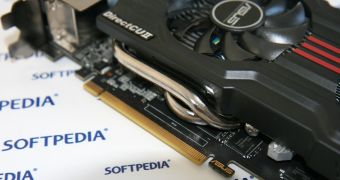
 14 DAY TRIAL //
14 DAY TRIAL // 

